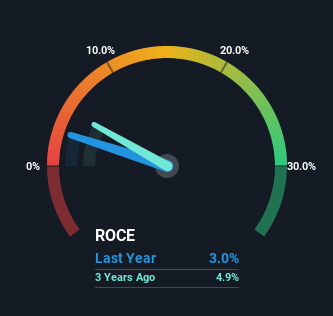- Saudi Arabia
- /
- Food
- /
- SASE:4080
Here's What's Concerning About Aseer Trading Tourism and Manufacturing's (TADAWUL:4080) Returns On Capital

Ignoring the stock price of a company, what are the underlying trends that tell us a business is past the growth phase? Businesses in decline often have two underlying trends, firstly, a declining return on capital employed (ROCE) and a declining base of capital employed. Trends like this ultimately mean the business is reducing its investments and also earning less on what it has invested. On that note, looking into Aseer Trading Tourism and Manufacturing (TADAWUL:4080), we weren't too upbeat about how things were going.
Return On Capital Employed (ROCE): What is it?
Just to clarify if you're unsure, ROCE is a metric for evaluating how much pre-tax income (in percentage terms) a company earns on the capital invested in its business. The formula for this calculation on Aseer Trading Tourism and Manufacturing is:
Return on Capital Employed = Earnings Before Interest and Tax (EBIT) ÷ (Total Assets - Current Liabilities)
0.03 = ر.س64m ÷ (ر.س3.3b - ر.س1.1b) (Based on the trailing twelve months to March 2022).
Thus, Aseer Trading Tourism and Manufacturing has an ROCE of 3.0%. Ultimately, that's a low return and it under-performs the Food industry average of 8.5%.
View our latest analysis for Aseer Trading Tourism and Manufacturing

While the past is not representative of the future, it can be helpful to know how a company has performed historically, which is why we have this chart above. If you'd like to look at how Aseer Trading Tourism and Manufacturing has performed in the past in other metrics, you can view this free graph of past earnings, revenue and cash flow.
What Does the ROCE Trend For Aseer Trading Tourism and Manufacturing Tell Us?
In terms of Aseer Trading Tourism and Manufacturing's historical ROCE trend, it isn't fantastic. To be more specific, today's ROCE was 3.9% five years ago but has since fallen to 3.0%. What's equally concerning is that the amount of capital deployed in the business has shrunk by 37% over that same period. When you see both ROCE and capital employed diminishing, it can often be a sign of a mature and shrinking business that might be in structural decline. If these underlying trends continue, we wouldn't be too optimistic going forward.
While on the subject, we noticed that the ratio of current liabilities to total assets has risen to 34%, which has impacted the ROCE. If current liabilities hadn't increased as much as they did, the ROCE could actually be even lower. Keep an eye on this ratio, because the business could encounter some new risks if this metric gets too high.
Our Take On Aseer Trading Tourism and Manufacturing's ROCE
To see Aseer Trading Tourism and Manufacturing reducing the capital employed in the business in tandem with diminishing returns, is concerning. And long term shareholders have watched their investments stay flat over the last five years. Unless there is a shift to a more positive trajectory in these metrics, we would look elsewhere.
Aseer Trading Tourism and Manufacturing does have some risks though, and we've spotted 1 warning sign for Aseer Trading Tourism and Manufacturing that you might be interested in.
For those who like to invest in solid companies, check out this free list of companies with solid balance sheets and high returns on equity.
New: Manage All Your Stock Portfolios in One Place
We've created the ultimate portfolio companion for stock investors, and it's free.
• Connect an unlimited number of Portfolios and see your total in one currency
• Be alerted to new Warning Signs or Risks via email or mobile
• Track the Fair Value of your stocks
Have feedback on this article? Concerned about the content? Get in touch with us directly. Alternatively, email editorial-team (at) simplywallst.com.
This article by Simply Wall St is general in nature. We provide commentary based on historical data and analyst forecasts only using an unbiased methodology and our articles are not intended to be financial advice. It does not constitute a recommendation to buy or sell any stock, and does not take account of your objectives, or your financial situation. We aim to bring you long-term focused analysis driven by fundamental data. Note that our analysis may not factor in the latest price-sensitive company announcements or qualitative material. Simply Wall St has no position in any stocks mentioned.
About SASE:4080
Sinad Holding
Engages in manufacture, packaging, wholesale, and retail trade of food products in the Kingdom of Saudi Arabia, Egypt, other Arab countries, and internationally.
Fair value with acceptable track record.
Market Insights
Community Narratives




